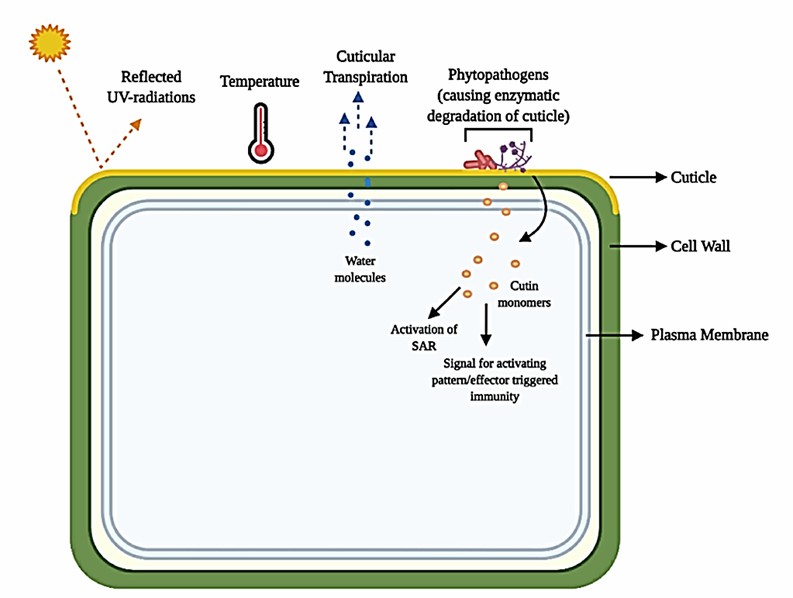The cuticle layer is the outermost layer of the plant. It performs various functions in plant protection, including resistance to abiotic stress environments (e.g., UV radiation and desiccation due to high temperatures) and biotic stress environments (e.g., pathogen invasion and pest feeding) (Fig. 1). Cuticle biosynthesis is influenced by both the natural environment and biotic action. The cuticle protects plants not only by acting as a passive physical barrier but also by inducing resistance. For example, the cuticle plays an essential role in systemic acquired resistance (SAR) through the activation of defense responses, which regulate the active transport of the plant defense-related hormone salicylic acid in vitro. Interestingly, a more permeable plant cuticle may lead to resistance or susceptibility to pathogenic infections. Understanding the impact of cuticle amount, composition, and structure on plant-pathogen interactions will facilitate the development of promising plant protection strategies. Lifeasible offers services to help study the role of the plant cuticle in plant-pathogen interactions.
 Fig. 1 Interaction of plant cuticle with various abiotic and biotic factors (Bhanot et al., 2021).
Fig. 1 Interaction of plant cuticle with various abiotic and biotic factors (Bhanot et al., 2021).
To aid research into the role of the plant cuticle in plant-pathogen interactions, we offer two main research services, including cuticular wax research and cutin research. In addition, we also help with the overall study of the plant cuticle.
We help analyze the amount, composition, and structure of cuticular waxes and explore the effects of different cuticular waxes on resistance to plant pathogens. And we help explore the role of genes involved in wax synthesis and regulation.
We help analyze the amount, composition, and structure of cutin and explore the effects of different cutin on resistance to plant pathogens. We also help explore the role of genes in regulating the production, polymerization, and translocation of cutin monomers.
For the integrated role of the plant cuticle, we help analyze cuticular waxes and cutin in plant-pathogen interactions, the factors affecting cuticular waxes and cutin, and detect the plant resistance they induce. Furthermore, we also help explore other components of the cuticle and their role in plant-pathogen interactions, including phenolics and suberin.
Advanced equipment
We have advanced equipment for cuticle analysis, including transmission electron microscopy (TEM), scanning electron microscopy (SEM), high-resolution magic angle spinning (HR-MAS) nuclear magnetic resonance (NMR) spectroscopy, gas chromatography-mass spectrometry (GC-MS) equipment, and X-ray diffraction equipment. We can help to efficiently analyze the amount, structure, and composition of cuticular waxes and cutin.
Integrated studies
Not only can we analyze the effect of cuticle changes on plant resistance to pathogens, but we can also specifically analyze the expression of genes associated with cuticle changes, including genes related to cuticle synthesis, translocation, and polymerization. Overall, we can achieve a comprehensive analysis of cuticle changes and a comprehensive study of cuticle-related plant-pathogen interactions.
Rigorous manipulation
The alteration of the plant cuticle is also related to environmental factors. It is important to perform a strict control experiment to ensure that no other factors interfere with the experiment. We perform our experiments strictly to ensure that the results are of high quality.
Lifeasible helps to analyze the role of the plant cuticle in plant-pathogen interactions. We master professional analytical methods, have advanced equipment, and operate rigorous experiments. We are the ideal partner for your plant protection-related cuticle research. Please contact us to accelerate your project.
References